Qigong.ppt
- Количество слайдов: 13
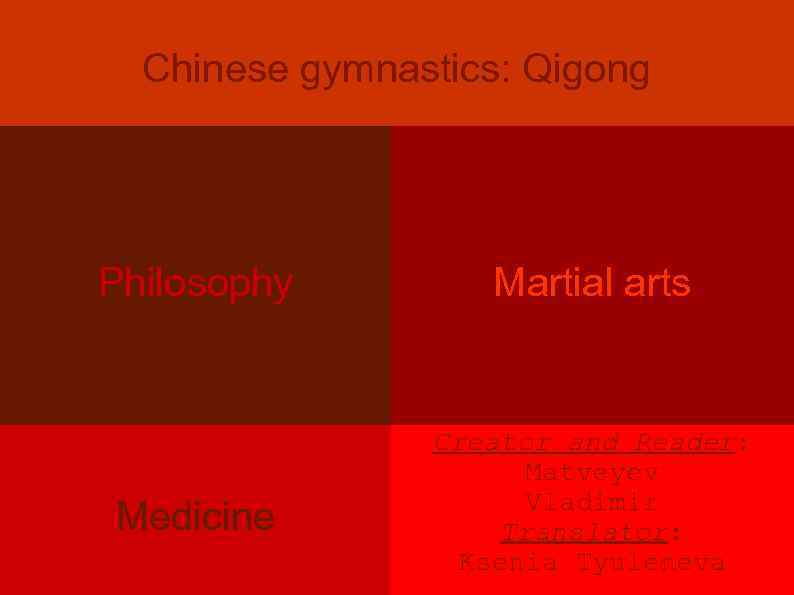 Chinese gymnastics: Qigong Philosophy Medicine Martial arts Creator and Reader: Matveyev Vladimir Translator: Ksenia Tyuleneva
Chinese gymnastics: Qigong Philosophy Medicine Martial arts Creator and Reader: Matveyev Vladimir Translator: Ksenia Tyuleneva
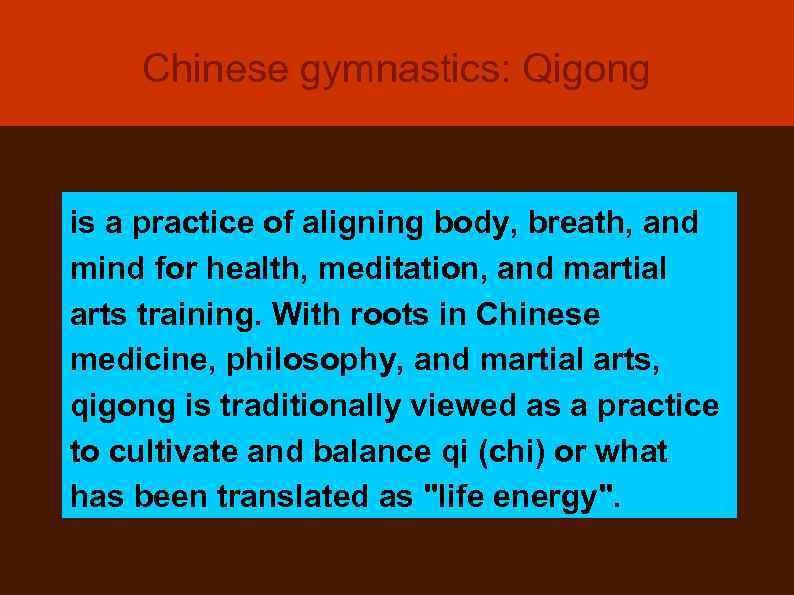 Chinese gymnastics: Qigong is a practice of aligning body, breath, and mind for health, meditation, and martial arts training. With roots in Chinese medicine, philosophy, and martial arts, qigong is traditionally viewed as a practice to cultivate and balance qi (chi) or what has been translated as "life energy".
Chinese gymnastics: Qigong is a practice of aligning body, breath, and mind for health, meditation, and martial arts training. With roots in Chinese medicine, philosophy, and martial arts, qigong is traditionally viewed as a practice to cultivate and balance qi (chi) or what has been translated as "life energy".
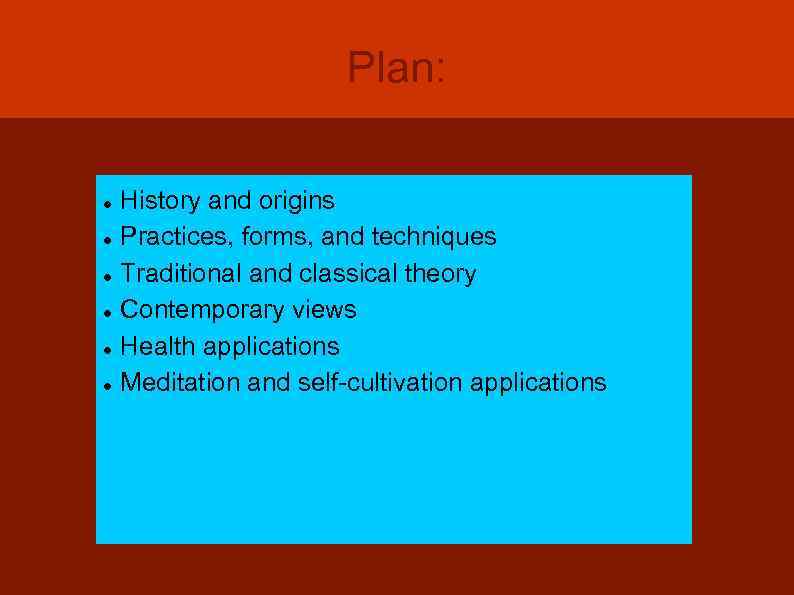 Plan: History and origins Practices, forms, and techniques Traditional and classical theory Contemporary views Health applications Meditation and self-cultivation applications
Plan: History and origins Practices, forms, and techniques Traditional and classical theory Contemporary views Health applications Meditation and self-cultivation applications
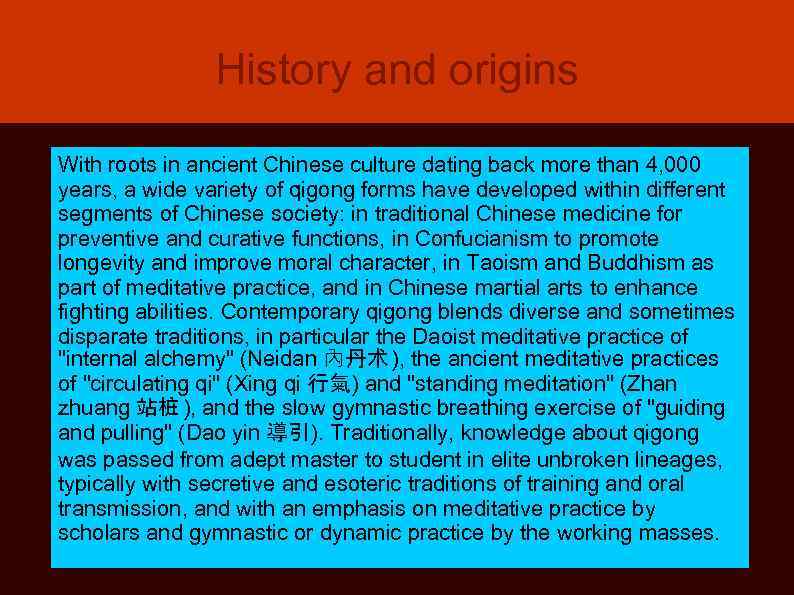 History and origins With roots in ancient Chinese culture dating back more than 4, 000 years, a wide variety of qigong forms have developed within different segments of Chinese society: in traditional Chinese medicine for preventive and curative functions, in Confucianism to promote longevity and improve moral character, in Taoism and Buddhism as part of meditative practice, and in Chinese martial arts to enhance fighting abilities. Contemporary qigong blends diverse and sometimes disparate traditions, in particular the Daoist meditative practice of "internal alchemy" (Neidan 內丹术 ), the ancient meditative practices of "circulating qi" (Xing qi 行氣) and "standing meditation" (Zhan zhuang 站桩 ), and the slow gymnastic breathing exercise of "guiding and pulling" (Dao yin 導引). Traditionally, knowledge about qigong was passed from adept master to student in elite unbroken lineages, typically with secretive and esoteric traditions of training and oral transmission, and with an emphasis on meditative practice by scholars and gymnastic or dynamic practice by the working masses.
History and origins With roots in ancient Chinese culture dating back more than 4, 000 years, a wide variety of qigong forms have developed within different segments of Chinese society: in traditional Chinese medicine for preventive and curative functions, in Confucianism to promote longevity and improve moral character, in Taoism and Buddhism as part of meditative practice, and in Chinese martial arts to enhance fighting abilities. Contemporary qigong blends diverse and sometimes disparate traditions, in particular the Daoist meditative practice of "internal alchemy" (Neidan 內丹术 ), the ancient meditative practices of "circulating qi" (Xing qi 行氣) and "standing meditation" (Zhan zhuang 站桩 ), and the slow gymnastic breathing exercise of "guiding and pulling" (Dao yin 導引). Traditionally, knowledge about qigong was passed from adept master to student in elite unbroken lineages, typically with secretive and esoteric traditions of training and oral transmission, and with an emphasis on meditative practice by scholars and gymnastic or dynamic practice by the working masses.
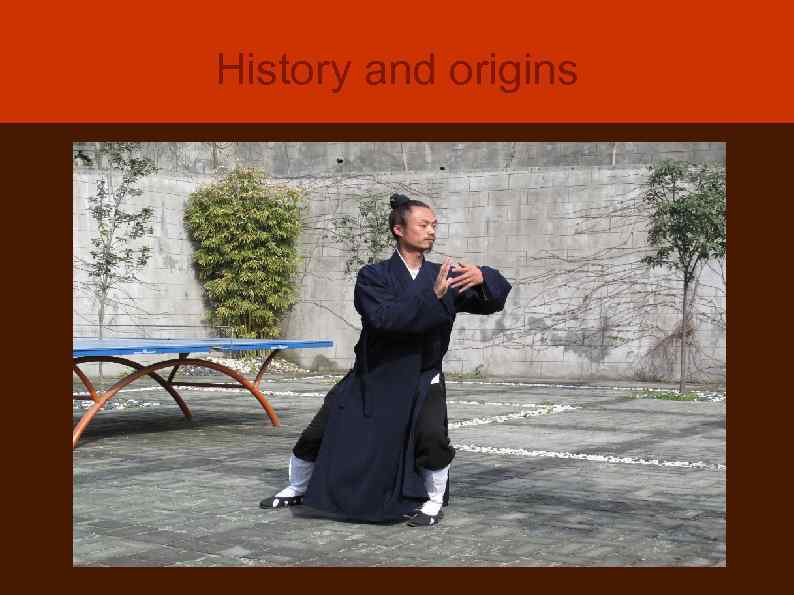 History and origins
History and origins
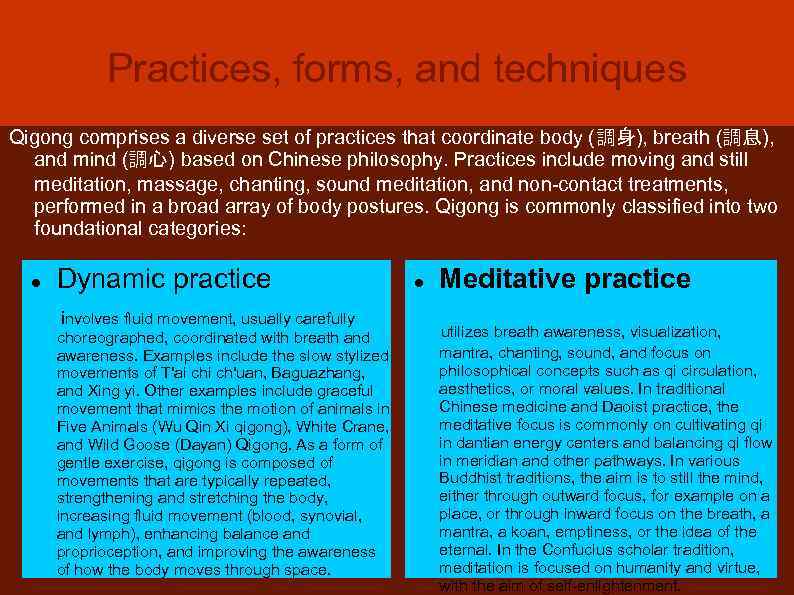 Practices, forms, and techniques Qigong comprises a diverse set of practices that coordinate body (調身), breath (調息), and mind (調心) based on Chinese philosophy. Practices include moving and still meditation, massage, chanting, sound meditation, and non-contact treatments, performed in a broad array of body postures. Qigong is commonly classified into two foundational categories: Dynamic practice involves fluid movement, usually carefully choreographed, coordinated with breath and awareness. Examples include the slow stylized movements of T'ai ch'uan, Baguazhang, and Xing yi. Other examples include graceful movement that mimics the motion of animals in Five Animals (Wu Qin Xi qigong), White Crane, and Wild Goose (Dayan) Qigong. As a form of gentle exercise, qigong is composed of movements that are typically repeated, strengthening and stretching the body, increasing fluid movement (blood, synovial, and lymph), enhancing balance and proprioception, and improving the awareness of how the body moves through space. Meditative practice utilizes breath awareness, visualization, mantra, chanting, sound, and focus on philosophical concepts such as qi circulation, aesthetics, or moral values. In traditional Chinese medicine and Daoist practice, the meditative focus is commonly on cultivating qi in dantian energy centers and balancing qi flow in meridian and other pathways. In various Buddhist traditions, the aim is to still the mind, either through outward focus, for example on a place, or through inward focus on the breath, a mantra, a koan, emptiness, or the idea of the eternal. In the Confucius scholar tradition, meditation is focused on humanity and virtue, with the aim of self-enlightenment.
Practices, forms, and techniques Qigong comprises a diverse set of practices that coordinate body (調身), breath (調息), and mind (調心) based on Chinese philosophy. Practices include moving and still meditation, massage, chanting, sound meditation, and non-contact treatments, performed in a broad array of body postures. Qigong is commonly classified into two foundational categories: Dynamic practice involves fluid movement, usually carefully choreographed, coordinated with breath and awareness. Examples include the slow stylized movements of T'ai ch'uan, Baguazhang, and Xing yi. Other examples include graceful movement that mimics the motion of animals in Five Animals (Wu Qin Xi qigong), White Crane, and Wild Goose (Dayan) Qigong. As a form of gentle exercise, qigong is composed of movements that are typically repeated, strengthening and stretching the body, increasing fluid movement (blood, synovial, and lymph), enhancing balance and proprioception, and improving the awareness of how the body moves through space. Meditative practice utilizes breath awareness, visualization, mantra, chanting, sound, and focus on philosophical concepts such as qi circulation, aesthetics, or moral values. In traditional Chinese medicine and Daoist practice, the meditative focus is commonly on cultivating qi in dantian energy centers and balancing qi flow in meridian and other pathways. In various Buddhist traditions, the aim is to still the mind, either through outward focus, for example on a place, or through inward focus on the breath, a mantra, a koan, emptiness, or the idea of the eternal. In the Confucius scholar tradition, meditation is focused on humanity and virtue, with the aim of self-enlightenment.
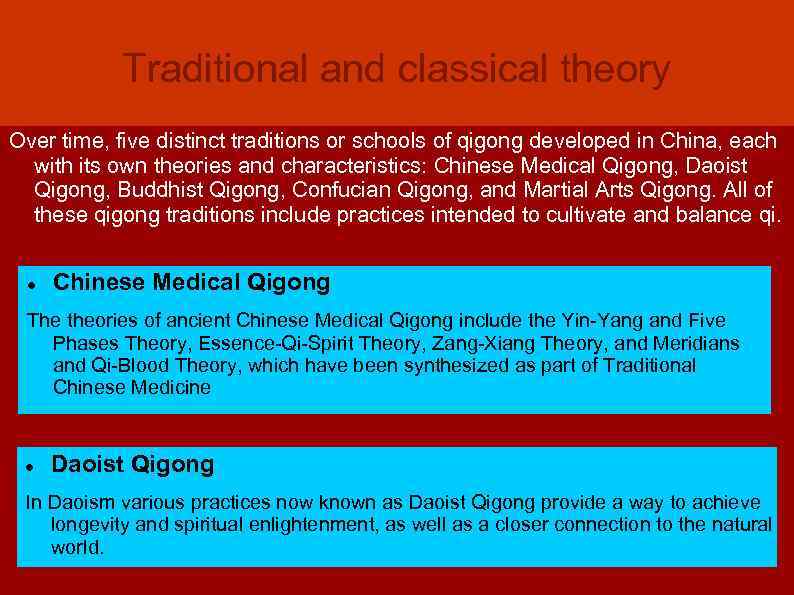 Traditional and classical theory Over time, five distinct traditions or schools of qigong developed in China, each with its own theories and characteristics: Chinese Medical Qigong, Daoist Qigong, Buddhist Qigong, Confucian Qigong, and Martial Arts Qigong. All of these qigong traditions include practices intended to cultivate and balance qi. Chinese Medical Qigong The theories of ancient Chinese Medical Qigong include the Yin-Yang and Five Phases Theory, Essence-Qi-Spirit Theory, Zang-Xiang Theory, and Meridians and Qi-Blood Theory, which have been synthesized as part of Traditional Chinese Medicine Daoist Qigong In Daoism various practices now known as Daoist Qigong provide a way to achieve longevity and spiritual enlightenment, as well as a closer connection to the natural world.
Traditional and classical theory Over time, five distinct traditions or schools of qigong developed in China, each with its own theories and characteristics: Chinese Medical Qigong, Daoist Qigong, Buddhist Qigong, Confucian Qigong, and Martial Arts Qigong. All of these qigong traditions include practices intended to cultivate and balance qi. Chinese Medical Qigong The theories of ancient Chinese Medical Qigong include the Yin-Yang and Five Phases Theory, Essence-Qi-Spirit Theory, Zang-Xiang Theory, and Meridians and Qi-Blood Theory, which have been synthesized as part of Traditional Chinese Medicine Daoist Qigong In Daoism various practices now known as Daoist Qigong provide a way to achieve longevity and spiritual enlightenment, as well as a closer connection to the natural world.
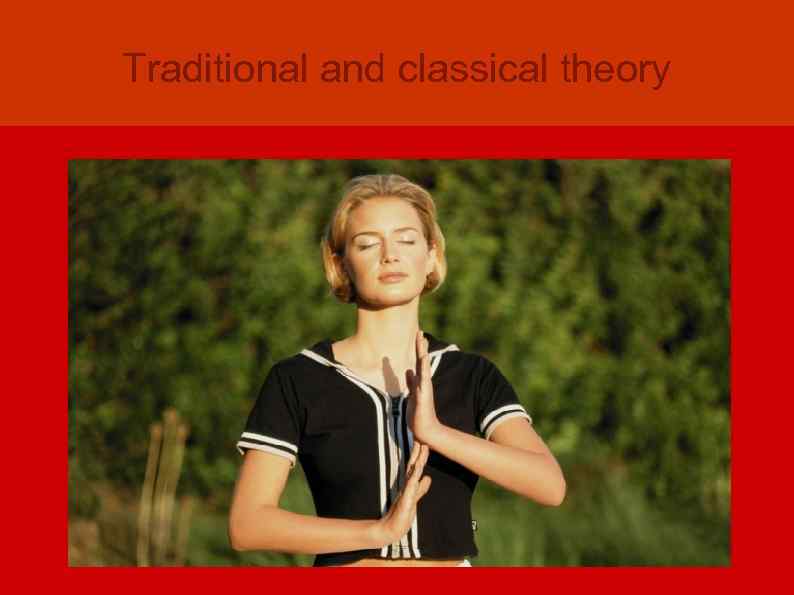 Traditional and classical theory
Traditional and classical theory
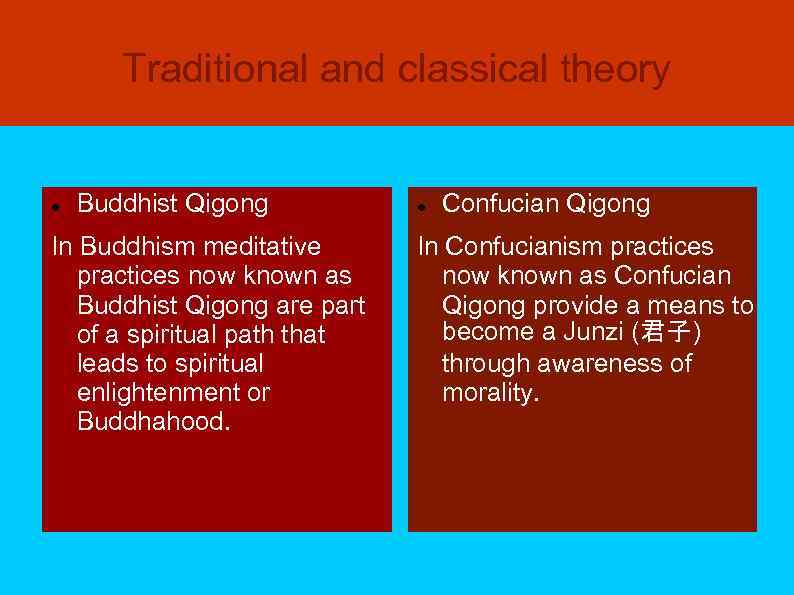 Traditional and classical theory Buddhist Qigong In Buddhism meditative practices now known as Buddhist Qigong are part of a spiritual path that leads to spiritual enlightenment or Buddhahood. Confucian Qigong In Confucianism practices now known as Confucian Qigong provide a means to become a Junzi (君子) through awareness of morality.
Traditional and classical theory Buddhist Qigong In Buddhism meditative practices now known as Buddhist Qigong are part of a spiritual path that leads to spiritual enlightenment or Buddhahood. Confucian Qigong In Confucianism practices now known as Confucian Qigong provide a means to become a Junzi (君子) through awareness of morality.
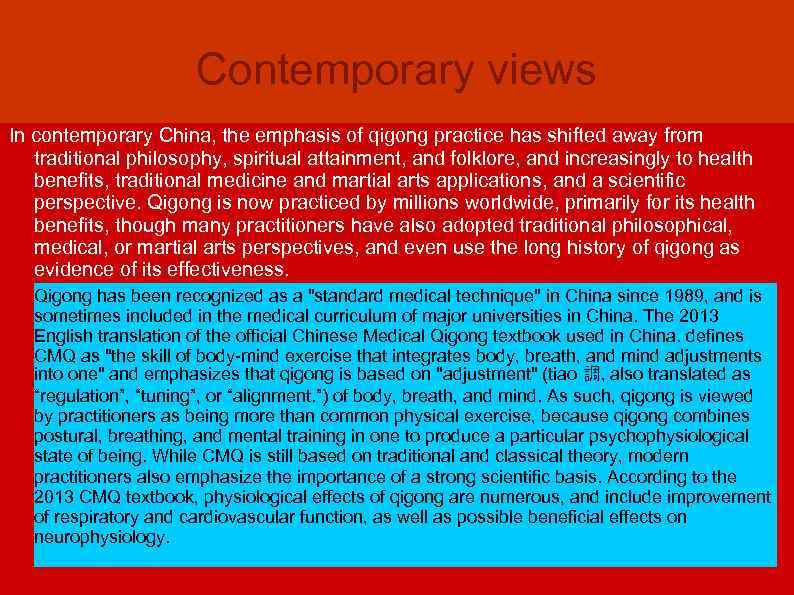 Contemporary views In contemporary China, the emphasis of qigong practice has shifted away from traditional philosophy, spiritual attainment, and folklore, and increasingly to health benefits, traditional medicine and martial arts applications, and a scientific perspective. Qigong is now practiced by millions worldwide, primarily for its health benefits, though many practitioners have also adopted traditional philosophical, medical, or martial arts perspectives, and even use the long history of qigong as evidence of its effectiveness. Qigong has been recognized as a "standard medical technique" in China since 1989, and is sometimes included in the medical curriculum of major universities in China. The 2013 English translation of the official Chinese Medical Qigong textbook used in China. defines CMQ as "the skill of body-mind exercise that integrates body, breath, and mind adjustments into one" and emphasizes that qigong is based on "adjustment" (tiao 調, also translated as “regulation”, “tuning”, or “alignment. ”) of body, breath, and mind. As such, qigong is viewed by practitioners as being more than common physical exercise, because qigong combines postural, breathing, and mental training in one to produce a particular psychophysiological state of being. While CMQ is still based on traditional and classical theory, modern practitioners also emphasize the importance of a strong scientific basis. According to the 2013 CMQ textbook, physiological effects of qigong are numerous, and include improvement of respiratory and cardiovascular function, as well as possible beneficial effects on neurophysiology.
Contemporary views In contemporary China, the emphasis of qigong practice has shifted away from traditional philosophy, spiritual attainment, and folklore, and increasingly to health benefits, traditional medicine and martial arts applications, and a scientific perspective. Qigong is now practiced by millions worldwide, primarily for its health benefits, though many practitioners have also adopted traditional philosophical, medical, or martial arts perspectives, and even use the long history of qigong as evidence of its effectiveness. Qigong has been recognized as a "standard medical technique" in China since 1989, and is sometimes included in the medical curriculum of major universities in China. The 2013 English translation of the official Chinese Medical Qigong textbook used in China. defines CMQ as "the skill of body-mind exercise that integrates body, breath, and mind adjustments into one" and emphasizes that qigong is based on "adjustment" (tiao 調, also translated as “regulation”, “tuning”, or “alignment. ”) of body, breath, and mind. As such, qigong is viewed by practitioners as being more than common physical exercise, because qigong combines postural, breathing, and mental training in one to produce a particular psychophysiological state of being. While CMQ is still based on traditional and classical theory, modern practitioners also emphasize the importance of a strong scientific basis. According to the 2013 CMQ textbook, physiological effects of qigong are numerous, and include improvement of respiratory and cardiovascular function, as well as possible beneficial effects on neurophysiology.
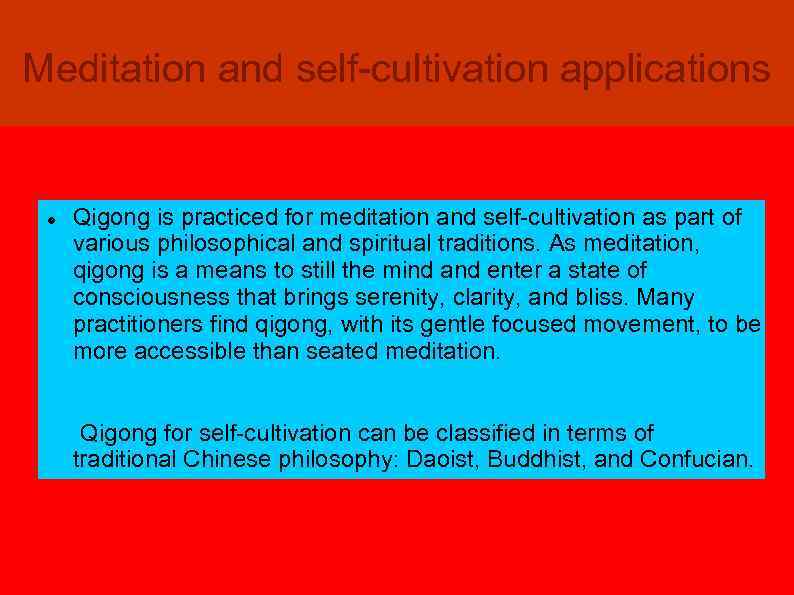 Meditation and self-cultivation applications Qigong is practiced for meditation and self-cultivation as part of various philosophical and spiritual traditions. As meditation, qigong is a means to still the mind and enter a state of consciousness that brings serenity, clarity, and bliss. Many practitioners find qigong, with its gentle focused movement, to be more accessible than seated meditation. Qigong for self-cultivation can be classified in terms of traditional Chinese philosophy: Daoist, Buddhist, and Confucian.
Meditation and self-cultivation applications Qigong is practiced for meditation and self-cultivation as part of various philosophical and spiritual traditions. As meditation, qigong is a means to still the mind and enter a state of consciousness that brings serenity, clarity, and bliss. Many practitioners find qigong, with its gentle focused movement, to be more accessible than seated meditation. Qigong for self-cultivation can be classified in terms of traditional Chinese philosophy: Daoist, Buddhist, and Confucian.
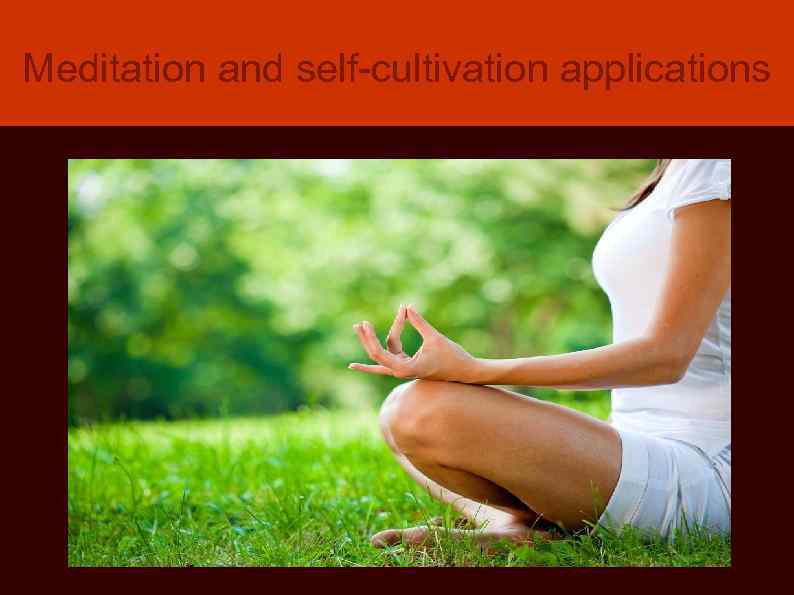 Meditation and self-cultivation applications
Meditation and self-cultivation applications
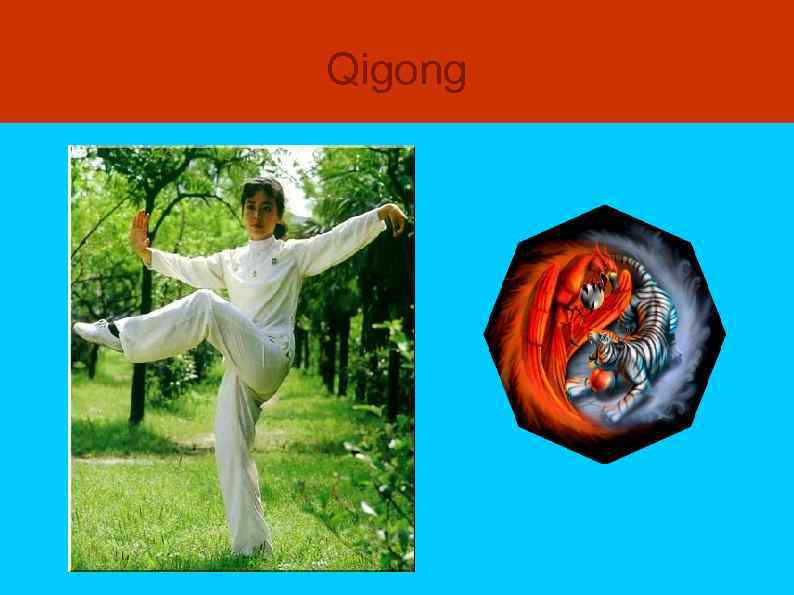 Qigong
Qigong
